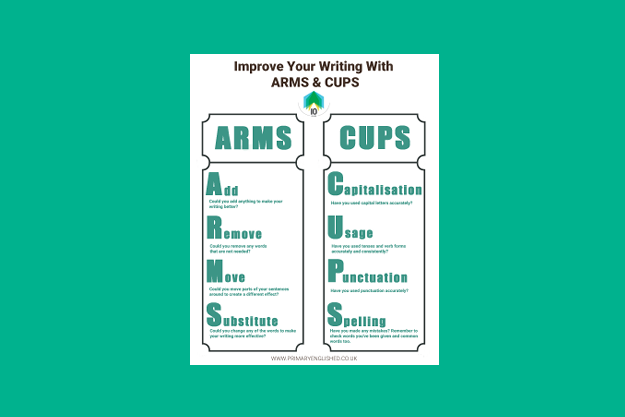Editing writing with ARMS and CUPS
I write often. I enjoy it – but am happy to admit that it requires determination, willpower and effort. My experiences are not unique. The challenge of the blank page is something that deters many writers from picking up their pen – I am amongst this number. Like other writers, I also think long and hard about organising my thoughts, finding a tone that connects with my reader, summoning the right words in the right order, and shaping my ideas into a cohesive whole. This all takes effort, and yet for me it is not the greatest challenge of writing. That is to come - the return of my work from an editor. I know it is essential. I know it will improve my writing. I know the recommendations are made with goodwill. And yet, the challenges I’ve overcome in creating my text mean that facing the critique and subsequent redrafting of my writing is deeply affecting.
If these are the feelings of a grown woman, just imagine how our children feel when they've toiled through their writing lessons to be then asked to improve what they’ve written.
So, how can we ease their pain?
First off, asking children to edit an entire composition every time they write is not, in my opinion, the best way to teach them editing and improving. As I've just set out, I find editing hurts my soul, and I don't want children to experience this pain. In my opinion, it is far more effective to select a small section of their writing to redraft.
We also need to show children how to redraft their writing. We need to model the process. I find using a text written by one of the children in the class, or creating a teacher-made example that exemplifies written features the class need to improve are both good starting points.
As we model this process, we then need to show children how to edit and proofread. It is tempting to combine these two processes but teasing them out and treating them separately increases their effectiveness. If you are in any doubt about the difference between them, editing is the more subjective of the two, and likely the one that your children find more challenging. It deals with the sound of writing. Proofreading is the more straightforward as it focuses on the look of writing, such as the accuracy of the spelling and punctuation.
To improve writing effectively, it's best to edit first and proofread second. Why?
Well, editing involves cutting, adding, and moving words and phrases. As a consequence of this moving and cutting, it's likely you'll need to readjust punctuation, and you could even make new spelling errors. In short, proofreading first is a waste of time.
For many years I've been supporting teachers to teach editing and proofreading and as part of those discussions I've used the ARMS and CUPS aide memoire first as a systematic approach to editing and proofreading for them but also to build independent editing skills in their children. It’s an incredibly simple approach to evaluating, improving and redrafting and one that the teachers I have worked with have embraced enthusiastically.
When showing children how to do their ARMS, we are helping them to assess how their writing sounds. When demonstrating how to do their CUPS, we are supporting them to evaluate the look of their writing.
ARMS and CUPS is not age-groups specific as it can be interpreted through the lens of the grammar, spelling and punctuation that the children have encountered so far. I generally suggest introducing it during Year 2 and continuing with it throughout key stage 2.
So, if you like what you see and want to take the pain out of editing and proofreading, why not download our FREE ARMS and CUPS posters. We have two versions – illustrated and text only. They are perfect for sticking into children’s workbooks or for displaying in the classroom.
Looking for more support with writing? Check out this article about cohesion which includes a link to our free Cohesion Road Map.



